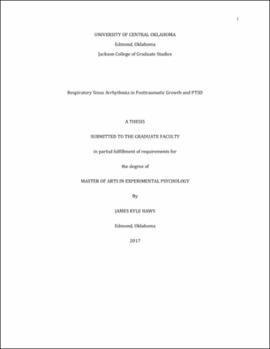| dc.contributor.advisor | Lack, Caleb | |
| dc.contributor.author | Haws, James Kyle | |
| dc.date.accessioned | 2020-07-09T14:39:57Z | |
| dc.date.available | 2020-07-09T14:39:57Z | |
| dc.date.issued | 2017 | |
| dc.identifier.other | (AlmaMMSId)9982550883402196 | |
| dc.identifier.uri | https://hdl.handle.net/11244/325039 | |
| dc.description.abstract | Most the human population will experience a traumatic event during their lifespan and will then cope with such trauma in a wide variety of ways. It is well documented that traumatic events are associated with both short and long-term psychological distress and that a small number of those trauma-exposed individuals will even develop a mental health disorder such as PTSD. In more recent empirical studies, some trauma-exposed individuals have been found to experience what has been labeled posttraumatic growth (PTG), or positive personal and psychological changes after experiencing trauma. However, there is significant controversy regarding PTG and its relationship with posttraumatic stress. This project attempts to provide clarity to one area of research about posttraumatic growth: how the physiological response of cardiac vagal regulation differs between those with PTSD and those with reported PTG. It was expected that individuals with PTG will not statistically differ from healthy controls on mean RSA. The findings confirm the proposed relationship between cardiac vagal tone, measured through RSA, and PTG. This study exemplifies that PTG is not an adaptive response to traumatic experiences, but instead a predictor of cardiac vagal rigidity. In each phase, RSA and heart period are lower in the PTG group, signifying less parasympathetic control over respiration and heart activity. More importantly, absence of cardiac vagal regulation post-aversive image task accompanied by lower RSA in PTG during this period strongly suggests that this construct is characterized by extreme affect dysregulation. A limitation in this study is that the sample was homogenous and only females participated in the laboratory portion of the study, which hinders the generalizability. Future research should investigate cardiac vagal activity with a stronger experimental manipulation, which can be done by using specific trauma centered memories or cues to examine the autonomic activity between those with reported PTG and PTSD. | |
| dc.rights | All rights reserved by the author, who has granted UCO Chambers Library the non-exclusive right to share this material in its online repositories. Contact UCO Chambers Library's Digital Initiatives Working Group at diwg@uco.edu for the permission policy on the use, reproduction or distribution of this material. | |
| dc.subject.lcsh | Post-traumatic stress disorder | |
| dc.subject.lcsh | Posttraumatic growth | |
| dc.subject.lcsh | Vagus nerve | |
| dc.subject.lcsh | Psychology, Experimental | |
| dc.title | Respiratory sinus arrhythmia in posttraumatic growth and PTSD. | |
| dc.type | Academic theses | |
| dc.contributor.committeeMember | Jeyaraj-Powell, Tephillah | |
| dc.contributor.committeeMember | Burr, Brandon | |
| dc.thesis.degree | M.A., Experimental Psychology | |
| dc.subject.keywords | Polyvagal theory | |
| dc.subject.keywords | Postraumatic growth | |
| dc.subject.keywords | PTSD | |
| dc.subject.keywords | Repiratory sinus arrhythmia | |
| dc.subject.keywords | Trauma | |
| dc.subject.keywords | Vagal tone | |
| dc.identifier.oclc | (OCoLC)on1007551291 | |
| uco.group | UCO - Graduate Works and Theses::UCO - Theses | |
| thesis.degree.grantor | Jackson College of Graduate Studies. | |
